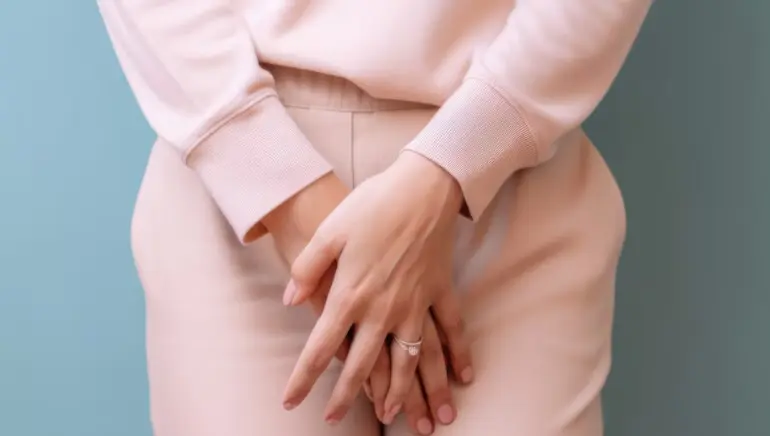7 Causes and Solutions for Pink Vaginal Discharge
Not every pink discharge is alarming, especially if it occurs around the time of your menstrual cycle. Here are a few all-natural solutions to the issue.
Vaginal discharge that is pink might have several reasons. Picture sourced from Adobe Stock
Did you know that a typical aspect of health is vaginal discharge? It is your body’s method of maintaining equilibrium and cleanliness in that area. Similar to other physiological processes, discharge is subject to alter during your menstrual cycle according on your hormone levels and degree of exercise.
It may surprise you to learn that color may also change. But don’t worry if you occasionally notice pink discharge coming from your vagina before your periods! Usually, pink discharge happens when a tiny bit of blood combines with your regular vaginal secretions. Although it might occur at different points during your cycle, knowing the reason will help you feel less anxious. Now let’s explore the causes of pink discharge and how to avoid it.
What does vaginal pink discharge mean?
A 2020 research that was published in the Singapore Medical Journal states that vaginal discharge is a fluid that is secreted by glands in the cervix and vagina. It is a typical component of the body’s operation and might change in consistency, color, and quantity throughout the menstrual cycle. According to a research that was published in the Clinical Methods Journal, the discharge might occasionally be white, yellow, green, brown, or red.
Pink vaginal discharge can occur for a variety of causes. Picture sourced from Adobe Stock
Pink discharge, sometimes referred to as pinkish discharge, is a kind of vaginal discharge that is pink or light pink in color. It may occur prior to or following your menstrual cycle, and it could be accompanied by other symptoms like discomfort or cramping. Pink discharge often happens when little quantities of blood mix with your regular vaginal discharge. Although it may be frightening to witness, there is often no cause for concern, according to gynecologist and obstetrician Dr. Neha Khandelwal.
[web_stories title=”false” excerpt=”false” author=”false” date=”false” archive_link=”true” archive_link_label=”” circle_size=”150″ sharp_corners=”false” image_alignment=”left” number_of_columns=”1″ number_of_stories=”5″ order=”DESC” orderby=”post_title” view=”circles” /]
Reasons for vaginal pink discharge
Before your menstrual cycle, pink discharge might have a number of different causes. Among them are:
1. Variations in hormone levels
Your vaginal discharge’s color and consistency may fluctuate due to hormonal fluctuations. Hormonal abnormalities, such as those experienced during perimenopause or menopause, might result in pink discharge, the expert says.
2. Bleeding after implantation
According to a research published in the Human Reproduction Journal, pink discharge during infertility may be an indication of implantation hemorrhage, which happens when a fertilized egg adheres to the uterine lining. This usually happens six to twelve days after ovulation.
3. The menstrual cycle
You may get pink vaginal discharge at the beginning or conclusion of your menstrual cycle. It becomes pink as the clean discharge combines with menstrual blood. According to the expert, irregular or moderate periods that span a few days may seem pink in contrast to full flow.
To prevent pink vaginal discharge, drink plenty of water. Picture sourced from Adobe Stock
Also Read: 5 Simple At-Home Methods to Remove Cheek Blackheads
4. Infections caused by sex
Pink discharge before to menstruation can be caused by a number of STDs, including chlamydia and gonorrhea. In addition, these infections may result in itching, pain while urination, pelvic pain, and irregular bleeding, according a research that was published in the British Medical Journal.
5. Viral infection
A 2023 study that appeared in the StatsPearl Journal states that bacterial vaginosis (BV) is a common vaginal illness brought on by an unbalanced bacterial population in the vagina. Before their periods, women with BV may have pink, yellow, or greyish vaginal discharge that smells like fish. Other potential symptoms include vaginal discomfort, burning while urinating, and itching.
Also Read
6. Menopause
Estrogen levels fluctuate throughout the perimenopause, which is the time before menstruation ends. Variations in these hormones might result in irregular vaginal discharge and spotting. Additional symptoms might appear, including mood swings, vaginal dryness, heat flashes, and difficulty falling asleep. A woman’s perimenopause usually starts in her 40s, according to the specialist.
7. Complications during pregnancy
When a woman is pregnant, pink vaginal discharge might be concerning. It can indicate an issue with the pregnancy, including an ectopic pregnancy or a threatening miscarriage. See your doctor if you experience spotting or pink discharge while pregnant, advises the expert.
How to stop pink vaginal discharge naturally
Here are a few simple natural methods to help stop pink vaginal discharge:
1. Continue to practice cleanliness
- To keep the genital area dry and clean, wash it every day.
- Steer clear of harsh soaps and feminine care products since they may upset the vagina’s natural pH balance.
- To stop bacteria from moving from the anus to the vagina, always wipe after using the restroom from the front to the rear.
2. Consume more meals high in probiotics.
Managing vaginal discharge can be achieved by taking probiotic supplements or by eating more foods high in probiotics, such as yoghurt, kefir, sauerkraut, and kimchi. Probiotics can help restore the natural balance of bacteria in the vagina, reducing the incidence of illnesses like bacterial vaginosis, which naturally minimizes pink vaginal discharge, according to a study published in the Frontiers Cellular and Infection Microbiology Journal.
3. Maintain your fluid intake
An increased risk of vaginal infections has been associated with dehydration, according to a research published in the BMJ Open Quality Journal. Maintaining overall hydration and vaginal moisture via drinking at least eight glasses of water is beneficial to vaginal health. Reducing discharge before to the onset of menstruation is another benefit.
4. Engage in safe sexual behavior
Maintaining vaginal health requires having sexual relationships while using safeguards appropriately. According to the expert, using condoms correctly and regularly minimizes the risk of STIs, which in turn lessens the likelihood of developing a pink discharge.
5. Put on breathable clothing.
Put on cotton underwear to improve ventilation and keep the region dry. The specialist advises against wearing tight clothing, especially synthetic ones, since they can trap moisture and encourage the growth of germs and yeast, which can cause pink vaginal discharge.
Things to bear in mind!
These natural treatments won’t replace medical care, even though they could lessen the likelihood. See your doctor if you’re having a lot of pink vaginal discharge so you can get the treatment you need and find the underlying problem.
Also Read: Pink discharge: What is it, and why does it happen?
Health Conscious Plus
Welcome to Health Conscious Plus Find health insights, disease management tips, meal plans, and mindful living strategies for a healthier life.




